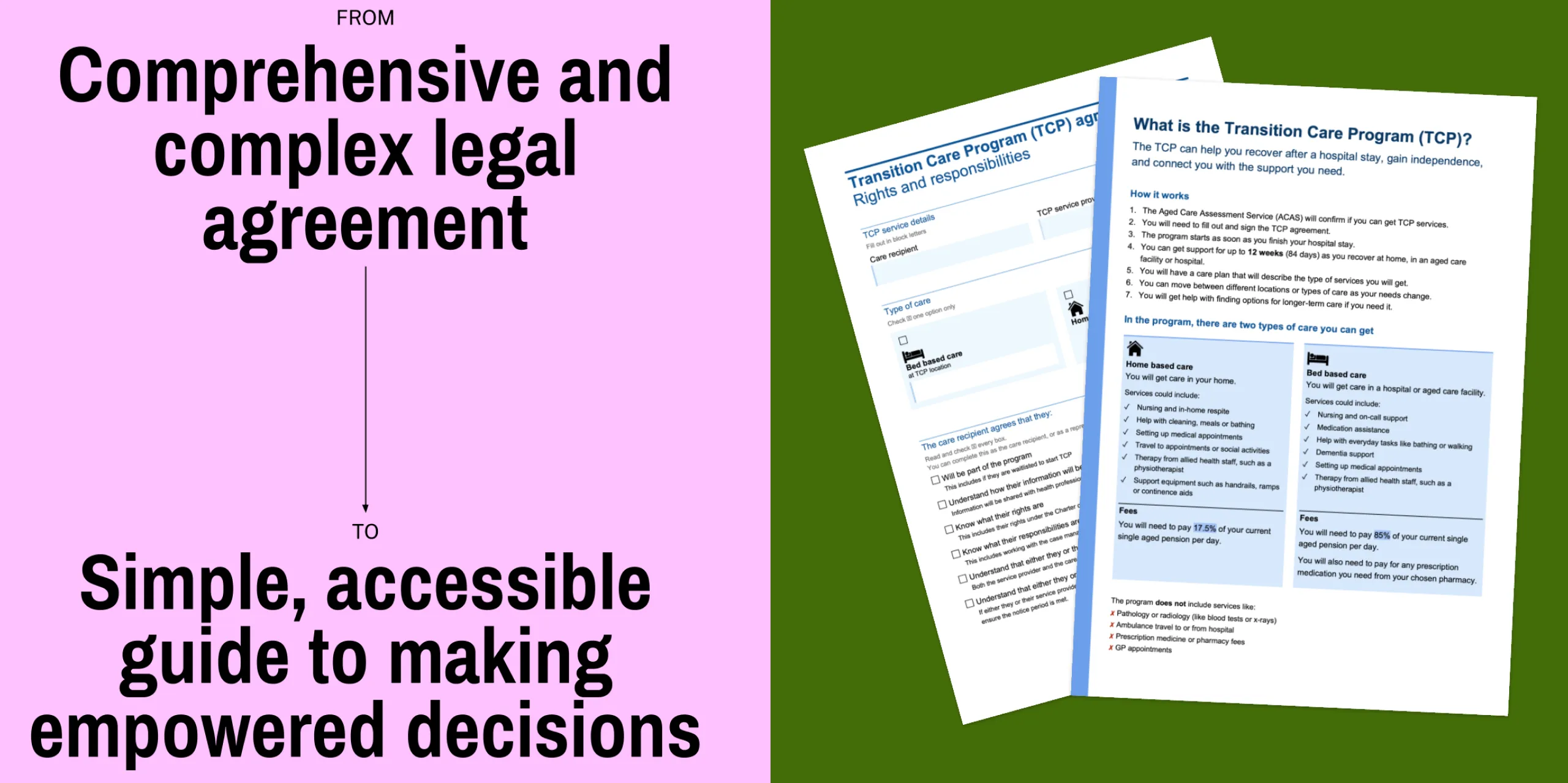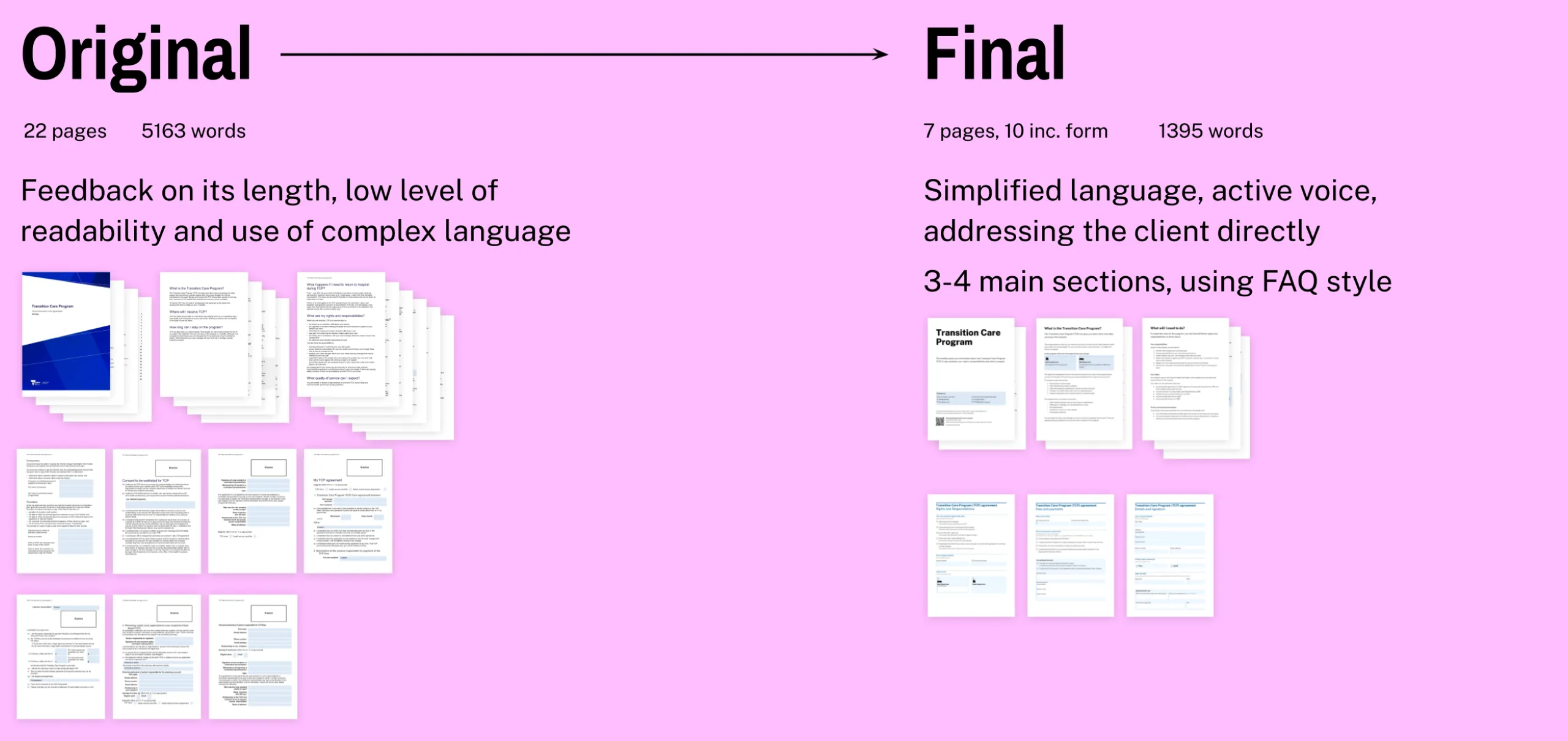Like many complex systems, our health system can be difficult to navigate and create change in.
Improving the system needs significant care, time and resources to overcome common challenges: there’s often many people involved, existing structures in place, immovable constraints and competing priorities to contend with.
While system-wide reform is necessary and important, not every change to our health system can be, or needs to be, transformational.
Sometimes it’s about finding a small (but meaningful) moment to iterate and improve.
This article talks about a recent project we undertook with the Victorian Department of Health. It shares how you can:
- Identify moments for change
- Use human-centred design to make change quickly
- Start small and scale
The challenge
The Victorian Department of Health’s Transition Care Program connects older patients who are recovering from illness or injury with support at home, in hospital or in aged care.
The project aimed to redesign an inclusive, accessible and clear care agreement that supports clients, carers and staff to take their next step in the Transition Care Program (TCP).
While the care agreement is just one step in a patient’s journey, it represents a significant moment of complexity in the program.
Receiving the agreement is often the first time the patient becomes aware of the program, including its benefits and requirements.
Patients are asked to review a 20+ page document, agree to its contents, sign up to make payments and provide lengthy personal information—all while recovering from serious injuries or illness.

What we did
In just 6 weeks, we needed to create a new version of the agreement that would powerfully change the patient and carer experience.
Here are 5 things we did as part of our process.
1. Identify the right moment
Every service has a moment (whether internal or audience facing) that could be made simpler.
As part of this project, our client from the Department of Health knew the current agreement wasn’t meeting the needs of older Victorians, their families and carers. Clocking in at 22 pages and over 5,000 words in length, it was full of complex legal jargon and an immediate candidate for re-design.
Our tips:
- Think about the different touch points your audience might experience: it could be as simple as a brainstorm with people in your team
- Consider the service moments that are experienced most often, and have the most scope for improvement
- Consider the complexity of the moment, is this something that can be improved by applying best practice, or does it require deeper consultation with your community before making progress?
- Think about the nature of the change required: is it something you can tackle quickly, or with resources available today? If yes, it might be a good candidate to make an impact, quickly.
- Consider making the change timebound: this might help you think about change you can get started on sooner for immediate uplift.
2. Take a hypothesis-led approach
To re-design the TCP agreement, we knew we would only have one opportunity to speak with service users. To maximise our time with them, we chose to take a hypothesis-led approach.
This meant we applied best practice design and content principles to the next iteration of the care agreement before going into research.
Our tips:
Simplifying complex or legacy content is an effective way to make a radical improvement to a service experience.
Here are some of the principles we considered:
Readable: How easy is it to read the agreement?
- Change longer sentences into shorter ones
- Use the simplest words possible (plain language)
- Use the active voice
Scannable: How quickly can someone understand what the agreement is about?
- Use headings and subheadings to break up big chunks of text
- Use bullets where relevant (e.g. lists, shorter statements) instead of longer paragraphs of text
- Where possible, use design elements to showcase content
Essential: Does the agreement give people the information they actually need?
- Review all content and consider what is necessary
- De-prioritise legal content, but offer a simpler explanation earlier in the agreement
Actionable: Does this agreement help people take their next step in the program?
- Understand the actions you want people to complete (e.g. sign the agreement and fill out the form)
- Consider how you can signpost key actions in different sections of the agreement
3. Find a way to speak with your audience
The people who actually used this agreement fell into a few different categories:
Older people: Older people recovering from injury and illness, but also living with a range of other physical and cognitive disabilities, frailness and other factors. This made it hard for them to engage with a lengthy and complex agreement.
Families and carers: Time-poor supporters who are already fatigued with the system
Due to this context, we understood that trying to engage these audiences over longer periods of time, or requiring specific types of participation and time investment (such as in traditional co-design or co-creation) would be challenging.
Instead, we opted to travel to them for 1:1 interviews, with plenty of time to get to know them, sit down for a chat and share the revised agreement for their feedback.
Our tips:
Not every engagement with your audience needs to be time intensive for them or your team, especially when considering the scope of the change you are trying to make:
- Consider what evidence or feedback you may already have from your service users: think about website analytics, direct feedback or existing service measures
- Think about the best moment to engage your users: is there a way to weave in the information you need as part of an existing touchpoint, such as a feedback form?
- Consider the way you choose to engage them: is there a method that will help you answer your research questions more efficiently, such as a survey or intercept?
4. Make it fit-for-purpose
We knew that to ensure the revised agreement was successfully implemented and not just a recommendation, we had to consider its context of use.
Instead of opting for Figma or InDesign to redesign our agreement, we used layouts that could be designed in Microsoft Word.
What could have been a limiting constraint, was a way to make the document fit-for-purpose. It meant that:
- It could be edited and updated as information changed over time
- It was easy to customise by adding logos or additional contact information
- It was easy to share with the various hospitals, aged care services and individuals who distributed the agreement
- It was a common and supported format for printing
- There is no requirement to use specialised software
Our tips:
It’s exciting to think about the ideal solution for the change you want to make, but it’s also valuable to think about how it could come to life in its simplest form.
Making something fit-for-purpose asks you to consider the basics around format, structure and context of use over aesthetics, personal preferences or opinions.
5. Scale the impact of the work
Even while system or service transformation is in progress, don’t underestimate the impact of improving a single moment.
Alongside the immediate impact for your service users, making small, incremental changes can:
- Create a sense of momentum and progress when things feel stuck
- Prove the value of change internally or externally, potentially leading to larger opportunities
- Create a ‘ripple effect’ across your organisation, where your learnings can be applied to other areas. Chances are, if it’s a low hanging fruit in your team, it’s probably an opportunity that needs re-design elsewhere.
Our tips:
Test and learn: Even once a change is made, there’s always opportunity to learn from the outcome. Set measures for success and look out for signals. What you observe will help you improve it further.
Share the improvement with others: Inspire others to implement the improvement you’ve made. Our client from the Department shared the agreement with both NSW and Queensland, which means the agreement could be used across more states.
Tell the story internally and externally: Sharing the process can be a useful way for others to spot opportunities in their own teams.

The outcome
In just 6 weeks, we re-designed a care agreement that was ready to be used across Victoria.
The original agreement’s length, density and multi-step format required readers to have level 3 literacy (Programme for the International Assessment of Adult Competencies, Australia, 2012).
According to Australia's last assessment of literacy, 44.2% of Australians between the ages of 15 and 74 would not be able to complete the original agreement. This also doesn't take into consideration other factors such as age, disability or CALD contexts.
We brought this to a more accessible level by reducing length from over 5000 words to 1800, without losing context or key information. This has also created a markedly improved readability score (suitable for those 9 years or older) and a 70% reduction in word count.
Our rapid redesign process means the agreement is already published , being used across Victoria, and is now translated into 21 different languages.
It was such a great project. We developed a terrific product that was embraced by the sector. We continue to be challenged to keep the agreement to 8 pages but also incorporate updates required with Aged Care Reforms.
Deborah Senior Senior Policy Advisor, Aged Care Assessment and Transition Care Program, Department of Health
The agreement has been shared with other states and territories, and adapted to meet their needs.
It was amazing to be able to get such a quality product in 6 weeks. Today staff were engaging, flexible and delightful to work with.
